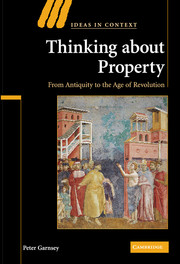Book contents
- Frontmatter
- Contents
- Abbreviations
- Preface
- Introduction
- Chapter 1 Plato's ‘communism’, Aristotle's critique and Proclus' response
- Chapter 2 Plato's ‘communism’: from late antiquity via Islamic Spain to the Renaissance
- Chapter 3 Renunciation and communality: thinking through the primitive Church
- Chapter 4 The poverty of Christ: crises of asceticism from the Pelagians to the Franciscans
- Chapter 5 The state of nature and the origin of private property: Hesiod to William of Ockham
- Chapter 6 The state of nature and the origin of private property: Grotius to Hegel
- Chapter 7 Property as a legal right
- Chapter 8 Property as a human right
- Conclusion
- Bibliography
- Index
Chapter 1 - Plato's ‘communism’, Aristotle's critique and Proclus' response
Published online by Cambridge University Press: 22 September 2009
- Frontmatter
- Contents
- Abbreviations
- Preface
- Introduction
- Chapter 1 Plato's ‘communism’, Aristotle's critique and Proclus' response
- Chapter 2 Plato's ‘communism’: from late antiquity via Islamic Spain to the Renaissance
- Chapter 3 Renunciation and communality: thinking through the primitive Church
- Chapter 4 The poverty of Christ: crises of asceticism from the Pelagians to the Franciscans
- Chapter 5 The state of nature and the origin of private property: Hesiod to William of Ockham
- Chapter 6 The state of nature and the origin of private property: Grotius to Hegel
- Chapter 7 Property as a legal right
- Chapter 8 Property as a human right
- Conclusion
- Bibliography
- Index
Summary
INTRODUCTION
Plato's ideal polity, or Kallipolis, is often characterized as a communistic society, in part or as a whole. Communism has been recently defined in this way:
[Communism is] the belief that society should be organized without private property, all productive property being held communally, publicly or in common. A communistic system is one based on a community of goods. It is generally presented as a positive alternative to competition, a system which is thought to divide people; communism is expected to draw people together and to create a community. In most cases the arguments for communism advocate replacing competition with cooperation either for its own sake or to provide a goal such as equality, or to free specific groups of people to serve a higher ideal such as the state or God.
The author proceeds to apply this (perfectly acceptable) definition to the ideal polity of the Republic: ‘The idea of communism as collectively owned property first appears in classical Greece. Plato's Republic contains a notable defence.’
This claim is mistaken. There is no collective or communal ownership of property in the ideal state of the Republic. Rather, Plato has Socrates prescribe for the political leadership and military (the Guards and Auxiliaries) an absence of property (coupled with a denial of individual families), or, to view it from a more positive angle, a community of use and a community of minds, involving the sharing of basic accommodation and subsistence, women and children, feelings and emotions.
- Type
- Chapter
- Information
- Thinking about PropertyFrom Antiquity to the Age of Revolution, pp. 6 - 30Publisher: Cambridge University PressPrint publication year: 2007
- 1
- Cited by



